In the world of manufacturing and process improvement, understanding time metrics is crucial for optimizing operations and delivering value to customers. Three fundamental metrics that often create confusion are takt time, cycle time, and lead time. While these terms may sound similar, each serves a distinct purpose in measuring and improving operational efficiency. This comprehensive guide will clarify these concepts and explain how they work together to create streamlined, customer-focused processes.
What Is Takt Time?
Takt time represents the rate at which a product must be completed to meet customer demand. The word “takt” comes from the German word for rhythm or beat, which perfectly describes its function in manufacturing. Takt time establishes the drumbeat of production, determining how frequently a product should be completed to satisfy market requirements without overproducing or underdeliving. You might also enjoy reading about How to Calculate Process Sigma Level: DPMO and Sigma Conversion Guide for Quality Excellence.
The formula for calculating takt time is straightforward: You might also enjoy reading about How to Create a Data Collection Plan: Step-by-Step Guide with Templates.
Takt Time = Available Production Time / Customer Demand You might also enjoy reading about Voice of Process: Measuring What Your Process Is Actually Doing.
For example, if a manufacturing facility operates for 480 minutes per day and customers order 240 units daily, the takt time would be 2 minutes. This means the facility must complete one unit every 2 minutes to meet customer demand exactly.
The Importance of Takt Time in Lean Six Sigma
Takt time serves as a critical metric in lean six sigma methodologies, particularly during the recognize phase when organizations identify opportunities for improvement. By aligning production pace with customer demand, companies can eliminate waste, reduce inventory costs, and ensure resources are utilized efficiently. Takt time acts as the foundation for creating balanced production lines where each workstation operates in harmony with customer requirements.
Understanding Cycle Time
Cycle time measures the actual time it takes to complete one unit of work from start to finish. Unlike takt time, which is determined by customer demand, cycle time reflects the current capability of your production process. This metric focuses on the internal efficiency of operations and reveals how quickly your team can actually produce goods or services.
Cycle time includes all the steps required to complete one unit, from the moment work begins until it is ready for the next stage or delivery. This encompasses both value-added activities (tasks that directly transform the product) and non-value-added activities (such as waiting, moving, or inspecting).
Types of Cycle Time
In practice, organizations often track different types of cycle time:
- Machine Cycle Time: The time a machine takes to complete its operation on one piece
- Operator Cycle Time: The time required for a worker to complete their tasks on one unit
- Overall Cycle Time: The total time from start to finish for the entire process
The Relationship Between Cycle Time and Takt Time
For efficient operations, cycle time should ideally be less than or equal to takt time. If cycle time exceeds takt time, production cannot keep pace with customer demand, leading to delays, backlogs, and dissatisfied customers. Conversely, if cycle time is significantly less than takt time, resources may be underutilized, or the organization might overproduce, creating excess inventory and associated carrying costs.
Defining Lead Time
Lead time represents the total time from the moment a customer places an order until they receive the finished product. This comprehensive metric encompasses everything that happens between order receipt and delivery, including processing time, production time, quality checks, packaging, and shipping.
Lead time can be broken down into several components:
- Order Processing Time: Time spent receiving, reviewing, and entering orders into the system
- Production Lead Time: Time required to manufacture the product
- Quality Assurance Time: Time spent inspecting and testing the product
- Packaging and Shipping Time: Time required to prepare and transport the product to the customer
Why Lead Time Matters
Lead time directly impacts customer satisfaction and competitive advantage. In today’s fast-paced market, customers expect quick delivery, and companies with shorter lead times often win more business. Reducing lead time has become a primary objective for organizations implementing continuous improvement methodologies.
How These Metrics Work Together
While each metric serves its own purpose, the true power lies in understanding how takt time, cycle time, and lead time interact within your operations. These metrics form a comprehensive picture of operational efficiency and customer responsiveness.
During the recognize phase of lean six sigma initiatives, teams analyze these time metrics to identify bottlenecks, waste, and improvement opportunities. This analysis reveals where processes deviate from ideal performance and where intervention can yield the greatest benefits.
Practical Application Example
Consider a furniture manufacturing company. Their takt time might be 30 minutes (based on customer orders), their cycle time for building a chair might be 25 minutes, and their total lead time from order to delivery might be 10 days. This information tells several stories:
- The cycle time being less than takt time indicates production capacity matches demand
- The 10-day lead time reveals opportunities to reduce the total time customers wait
- Analyzing each component of lead time can uncover specific areas for improvement
Strategies for Optimizing Time Metrics
Reducing Cycle Time
Organizations can reduce cycle time through various approaches including eliminating non-value-added activities, improving worker training, upgrading equipment, implementing standardized work procedures, and optimizing workstation layouts. Each improvement in cycle time increases capacity and responsiveness.
Matching Production to Takt Time
Balancing production lines to match takt time requires careful planning and continuous adjustment. This involves distributing work evenly across stations, cross-training employees to handle multiple tasks, and maintaining flexible capacity to respond to demand fluctuations.
Shortening Lead Time
Lead time reduction often requires a holistic approach that examines the entire value stream. Strategies include improving order processing systems, reducing batch sizes, implementing pull systems, improving supplier relationships, and streamlining quality control processes.
Common Mistakes to Avoid
When working with these time metrics, organizations frequently make several mistakes. The first is confusing the metrics with one another or using them interchangeably. Each metric serves a specific purpose and provides unique insights.
Another common error is focusing exclusively on one metric while ignoring the others. For example, obsessively reducing cycle time without considering takt time can lead to overproduction waste. Similarly, focusing only on lead time without understanding the underlying cycle times makes it difficult to identify root causes of delays.
Finally, many organizations fail to regularly update these metrics as conditions change. Customer demand fluctuates, processes improve, and capacity evolves. Time metrics must be recalculated periodically to remain relevant and useful.
Implementing Time Metrics in Your Organization
Successfully implementing these metrics requires a systematic approach. Begin by accurately measuring current performance for all three metrics. Ensure data collection methods are consistent and reliable. Involve frontline workers who understand the actual work processes and can provide valuable insights.
Next, establish target values based on customer requirements and competitive benchmarks. These targets should be challenging yet achievable, motivating continuous improvement while remaining realistic.
Create visual management systems that display these metrics prominently where teams can see them regularly. This transparency builds awareness, encourages accountability, and facilitates quick response to deviations.
Conclusion
Understanding the distinctions between takt time, cycle time, and lead time is essential for anyone involved in process improvement, operations management, or lean six sigma initiatives. Takt time sets the pace based on customer demand, cycle time measures actual production capability, and lead time reflects the total customer experience from order to delivery.
By monitoring and optimizing these three metrics together, organizations can create efficient, customer-focused operations that eliminate waste, reduce costs, and deliver value consistently. Whether you are in the recognize phase of a lean six sigma project or simply seeking to improve operational performance, these time metrics provide the foundation for data-driven decision making and continuous improvement.
The journey toward operational excellence begins with measurement, and these time metrics offer clear, actionable insights that drive meaningful change. Start by understanding your current state, set ambitious targets, and commit to the continuous improvement journey that leads to world-class performance.








